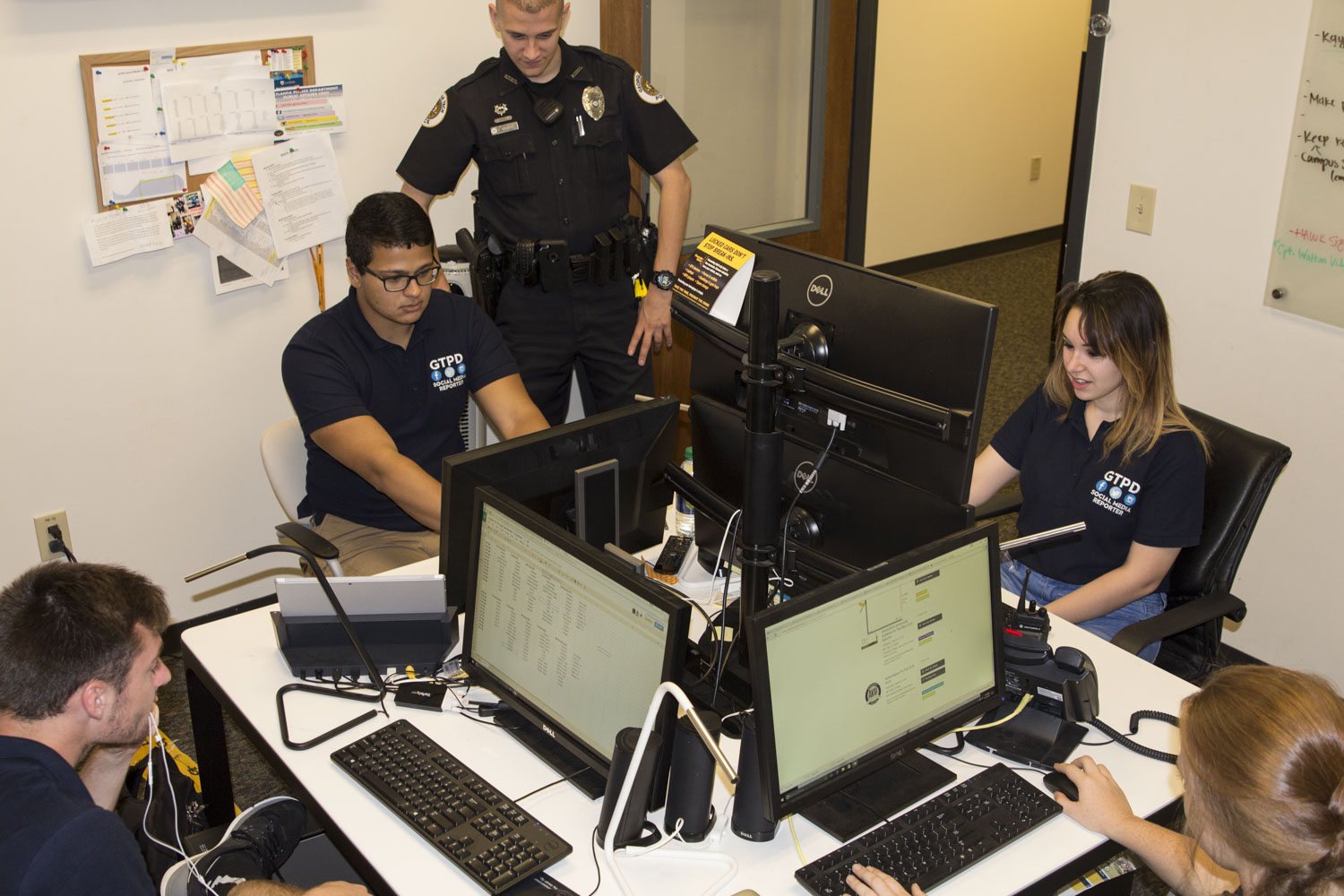GTPD Innovates to Bring Community Policing into the Digital Age

Led by Officer Loran Crabtree, the Georgia Tech Police Department has been operating a social media center since the end of spring semester 2016. The center is staffed by students who help GTPD connect with the student population on a variety of social media platforms.
When Sir Robert Peel established the London Metropolitan Police Department more than 180 years ago, he could not have foreseen the advent of social media and its impact on policing.
Among his very forward thinking principles, though, was this foundational concept for community policing: “The police are the public and the public are the police; the police being only members of the public who are paid to give full-time attention to duties which are incumbent on every citizen in the interests of community welfare and existence.”
Back in the spring semester, the Georgia Tech Police Department (GTPD) set up a social media center in its headquarters building, equipping it with computers, monitors and large-screen visual displays to begin interacting with students and other members of the campus community.
GTPD has recognized the use of social media as a means to connect with the Tech community in a meaningful way. Many law enforcement agencies have embraced social media and recognize it as a way to inform their communities and improve the reputation of their departments; however, most law enforcement agencies are not capitalizing on all of the benefits of social media.
“There’s no question that law enforcement needs to do a better job of connecting with the people whose lives they are working to protect,” said GTPD Chief Rob Connolly. “We believed that by initiating this center and hiring students to help us, we could make a real impact. We want to be completely transparent and let the campus and surrounding areas know that we are here for them.”
The GTPD social media center aims to not only increase outreach and engagement with the Georgia Tech community, but also promote safety by educating the public with tips, scan the various platforms and respond to concerns, improve emergency notifications, promote the efforts of the police department, provide early intervention and prevent threats of violence, self-harm and sexual assault.
In Peel’s day, police officers and their communities were highly connected. Police officers walked the beat. They built relationships and worked closely with all facets of the community to identify concerns and jointly work toward solutions. That is the essence of community policing.
During the last century, a number of advances in technology have led to a gradual separation of the police from the community. The expanding role of automobiles replaced the era of friendly foot patrol. Advances in telecommunications resulted in rapid contact with police through the 911 system, resulting in an overwhelming number of calls for service.
Answering calls, regardless or the urgency, severely limited a broad police interaction with the community. The advent of the computer also contributed to a decrease in police contact with the community. As computers generated data on crime patterns and trends, police professionals developed the prevailing ideology that they knew best how to deal with crime and disorder, and community involvement was seen as less important. Despite the negative consequences of certain technological developments on police-community relations, technology can help the police enhance their relationships with the communities they serve.
Where else but the Georgia Institute of Technology would the police department be on the cutting edge of technology to make the campus community a safer environment for learning and research?
In a digital age where the use of smartphones, tablets and laptop computers is ever-present, technology is transforming our lives, making them better connected, quicker and safer. Nearly two-thirds of Americans (65 percent) use social networking sites. Social media is a powerful tool many law enforcement agencies can use to become more effective, preventative and trusted.
“Law enforcement agencies are beginning to see how useful social media can be as a tool to fight crime,” Connolly said. “We’re not using it as a ‘Big Brother’ kind of thing to see what’s going on at parties. We’re trying to make use of state-of-the-art technologies to keep our campus and surrounding community safe.”
The center is led by Officer Loran Crabtree. As the social media coordinator for GTPD, Crabtree has a team of students who work part-time responding to questions, providing input on what types of posts would connect with students most effectively, and addressing misinformation that filters onto social media platforms about incidents and police tactics.
“The students are absolutely essential to accomplishing our objectives,” Crabtree said. “They have really helped us engage with other students. They know what works and what doesn’t, and it helps us to be more authentic when we’re interacting on social media.”
GTPD maintains an official presence on Facebook, Twitter, Instagram, Snapchat, Yik Yak, YouTube, Periscope and reddit. The results have varied per platform, but this recent post on the anonymous, geo-fenced network Yik Yak is a typical response:
“TBH (to be honest) the only reason I have Yik Yak at this point is because I appreciate GTPD updates.”
In the spring, GTPD helped apprehend a bank robbery suspect who fled from Midtown on foot and hid behind a fraternity house. Rumors swirled on social media that GTPD was raiding the fraternity for illegal activity.
A student assistant from the social media center was dispatched to the scene, where she took a picture and posted an update indicating what was really happening at the fraternity. It brought a quick end to the speculation and set the record straight.
“That’s a perfect example of how social media works,” Connolly said. “As time goes on, I believe we’ll have more success stories as the campus joins in with what we’re doing.”
This semester’s student staff include Cameron Garcia, Haley Logan, Cody Schoenfuss, Awnish Choudhary, Tyler Bennett, Tyler Merriweather, Kareem Edwards and Pragya Saboo.